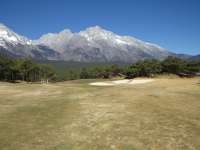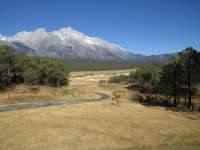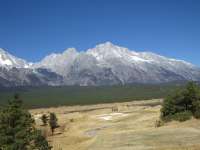Among golf connoisseurs, the most disheartening courses tend to be either those with a lofty reputation that disappoint, or others that are poor but set in a promising and beautiful locale. Jade Dragon in Yunnan Province, China, is one such course.
Marketed as the world’s longest layout, and set in the shadows of the unconquered Jade Dragon Snow Mountain (5596m), the Neil Haworth designed course has but one redeeming feature, its location. From most holes the view of the mountain is sublime, and near the course is the ancient UNESCO Heritage listed town of Lijiang, one of China’s most beautiful. The clubhouse is also interesting, but sadly once you step onto the 1st tee the air gets sucked out of both your lungs and also the experience itself.
Haworth’s course had real potential, given the space, scenery and some decent elevation changes. Instead of trying to build good holes, however, he seems to have been fixated on building long ones, and complicating his design with bunkers and other hazards. Aligning holes toward the mountain peaks was a wise move, but beyond the alignment there is little sophistication in either the routing or the design of the individual holes. The bunkering is especially poor. Good players often have to bomb straight over traps or across corners into uncomfortable areas just to get a look at the small greens, which are then rarely arranged to favor or even suit the approaching angle. The par threes aren’t immune either, with the 260-yard 12th featuring a tiny green set immediately beyond a massive bunker and angled away from the tee. Only the longest, highest hitting professionals could ever hope to hit and hold this green.
As for the world’s longest hole, the 711-yard 5th, it is poorly conceived with bunkers scattered everywhere and making little sense from either the tee or fairway. You can't hit your tee shot left of the central bunkers if too long or you run out of room, but carrying them means risking another cluster further up the fairway. This is your classic hit and hope hole, the yardage forces a driver but the bunkering suggests more care. As is common in many parts of Asia, the bunkers themselves are flat and quite shallow so good players won't mind being in them, they are just difficult for the average golfer who at times doesn’t have a sensible route around them.
Another crazy hole is the par five 16th, which features a beautiful drive across a prominent ridge but then you reach an enormous fairway that rises toward a green set beyond a Pine-covered gully. Unless you can hit your first two shots close to the trees you have no chance of hitting a third, from distance, up over the mature pines and onto a green you can't even see. The final par five, the 18th is barely any better, which is shame given how appealing this part of the world is as a tourist destination.
While the thinner air at altitude makes the golf ball travel farther, it would have been nice to see some subtlety here rather than just sheer length. We would visit Lijiang again in a heartbeat, and have no problem recommending this part of China for those interested in history, culture, mountains and clear blue skies. Golfers though should think carefully about packing their clubs, as Jade Dragon will frustrate those who don’t buy the old ‘no such thing as a bad day’s golf’ line.
A few years later, and I stand by my response when asked by a director what I thought of Jade Dragon – ‘It would be difficult to find the words to describe what I thought of your golf course….the scenery is beautiful.’

 this course also has exceptional:
this course also has exceptional:



